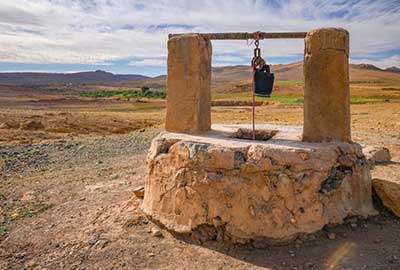Date: 25/04/2023
Relevance: GS-3: Conservation, Environmental Pollution, and Degradation, Environmental Impact Assessment.
Key Phrases: National Water Informatics Centre (NWIC), a network of groundwater sensors, Central Groundwater Board, Central Ground Water Authority, contamination, Ministry of Jal Shakti, Improved groundwater management.
Why in News?
- The Jal Shakti Ministry is working on a plan to deploy a vast network of groundwater sensors that will continuously measure the quality and contamination levels of groundwater in India.
- The sensors will relay information down to the taluk level and be available for monitoring by the National Water Informatics Centre (NWIC).
Current Monitoring System and its Limitations:
- The Central Groundwater Board currently relies on a network of around 26,000 groundwater observation wells that require manual measurement by technicians a few times a year.
- The information is communicated via reports from the Central Groundwater Board.
- This system has limitations as it only provides a snapshot of the groundwater levels and quality at a given time.
Digital Water Level Recorders:
- Under the new initiative, around 16,000-17,000 digital water level recorders will be connected to piezometers in the wells.
- Piezometers measure groundwater levels, and recorders digitally transmit the information.
- The Central Ground Water Authority (constituted under Environment (Protection) Act, 1986) aims to increase its network from the existing 26,000 to about 40,000 in the next three years.
- When combined with similar networks possessed by other institutions – State bodies, agriculture, and meteorology departments – India will have about 67,000 digitally recordable units to monitor groundwater dynamics.
- The network will provide high-resolution data and make groundwater visible much like air quality, and meteorological variables – air pressure, moisture, precipitation – are now.
Groundwater Extraction and Contamination in India:
- Reports suggest that 85% of rural India uses groundwater for drinking and domestic purposes, and in cities with a population of over 10 lakh, about 40% have seen water levels in monitored wells either stay stable or drop.
- Groundwater contamination in India is mostly "geogenic" (natural) and hasn't significantly changed over the years.
- However, nitrate contamination – a result of the use of nitrogenous fertilizers—has been observed.
- Sections of nearly 409 districts have been confirmed with fluoride contamination and parts of 209 districts have noted arsenic contamination.
Potential Benefits of the Groundwater Sensor Network:
- Continuous monitoring of groundwater levels:
- The new initiative will provide continuous information on groundwater levels, which will be helpful in predicting future levels, estimating extraction potential, and determining recharge potential.
- Improved groundwater management policies:
- The availability of continuous and up-to-date information on groundwater levels and quality can help policymakers make informed decisions on groundwater management policies.
- The Jal Shakti Ministry can provide updated advisories that can influence groundwater extraction policies by states.
- Improved agricultural practices:
- The Jal Shakti Ministry aims to provide groundwater forecasts to farmers that would be useful for sowing, and updated advisories that can influence groundwater extraction policies by States.
- Except for information on water flow governed by international treaties, most of this information will be publicly accessible.
- The continuous measurement of groundwater quality would benefit farmers and enable policymakers to take decisions that can help conserve and replenish groundwater resources.
- Better understanding of groundwater dynamics:
- The continuous monitoring of groundwater levels can help understand the complex dynamics of groundwater and the factors that affect it, such as land use changes, climate change, and recharge potential.
- Public access to groundwater information:
- The availability of groundwater data in a centralized network such as the National Water Informatics Centre (NWIC) can make groundwater visible much like air quality, and meteorological variables.
- Except for information on water flow governed by international treaties, most of this information will be publicly accessible.
- Identification of contaminated regions:
- The continuous monitoring of groundwater quality can help identify contamination sources, assess the effectiveness of pollution mitigation efforts, and track the progress of remediation programs.
- Those regions and States that are known to have groundwater contamination, for instance, coastal salinity or excessive depletion, will be monitored more intensely for action by states.
- Continuous monitoring of groundwater quality can help take necessary actions for remediation.
Conclusion:
- The Jal Shakti Ministry's initiative to establish a network that will continuously measure groundwater quality is a significant step toward water conservation and management in India.
- The continuous measurement of groundwater levels and contamination would benefit farmers, policymakers, and the general public.
- The government's focus on groundwater management is timely, given the increasing demand for groundwater resources and the associated risks of depletion and contamination.
- With the deployment of this vast network of groundwater sensors, India is on its way to achieving sustainable groundwater management.
Source: The Hindu
Mains Question:
Q. “India is one of the countries with the highest groundwater depletion rates in the world.” In light of this, discuss the Jal Shakti Ministry's plan to deploy a vast network of groundwater sensors and its potential benefits in ensuring sustainable groundwater management.







